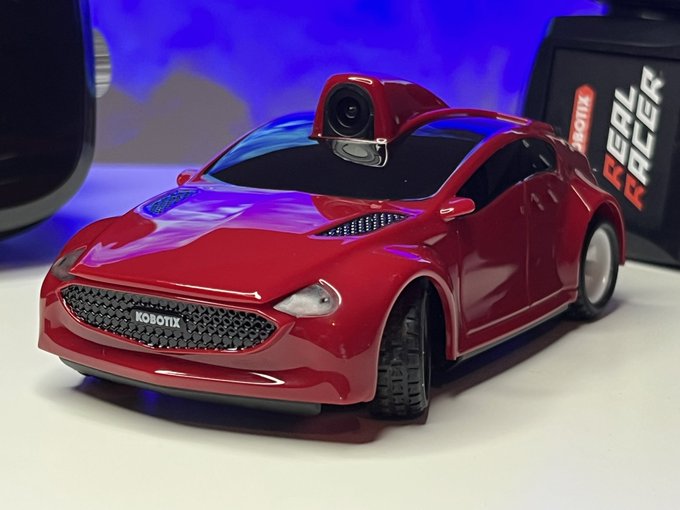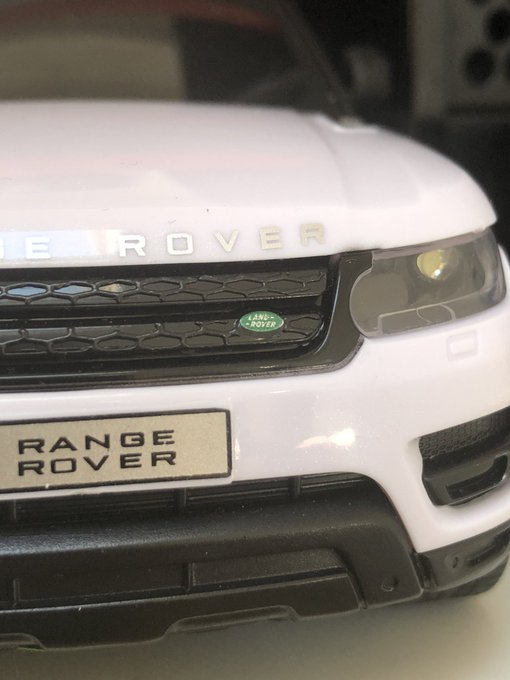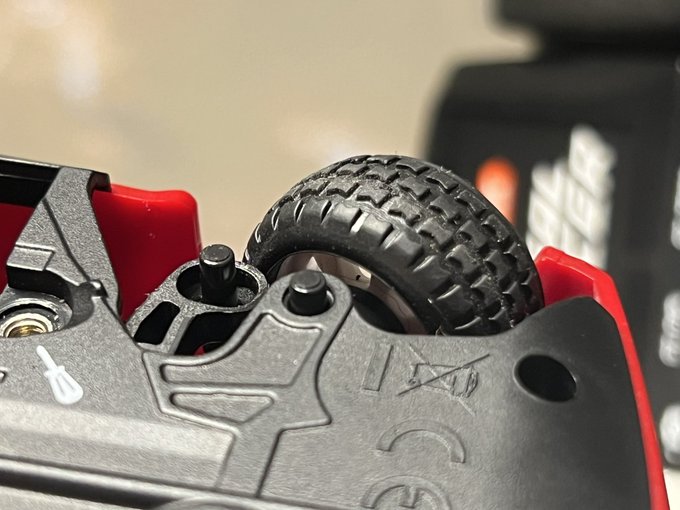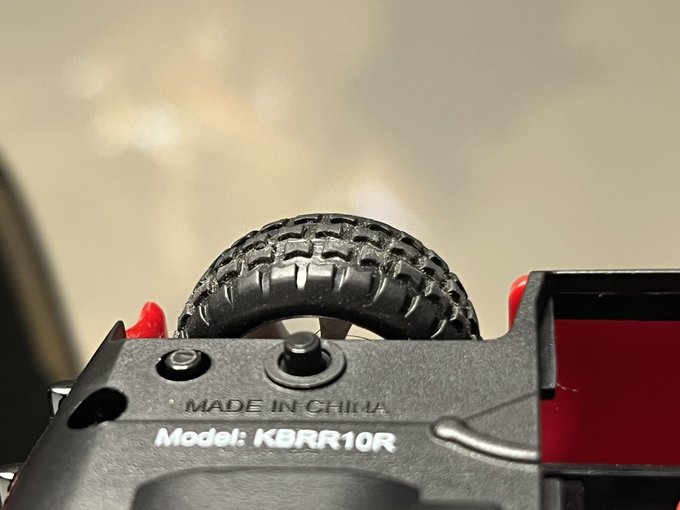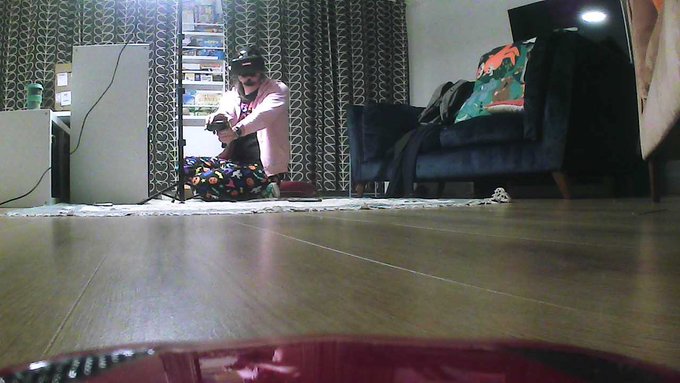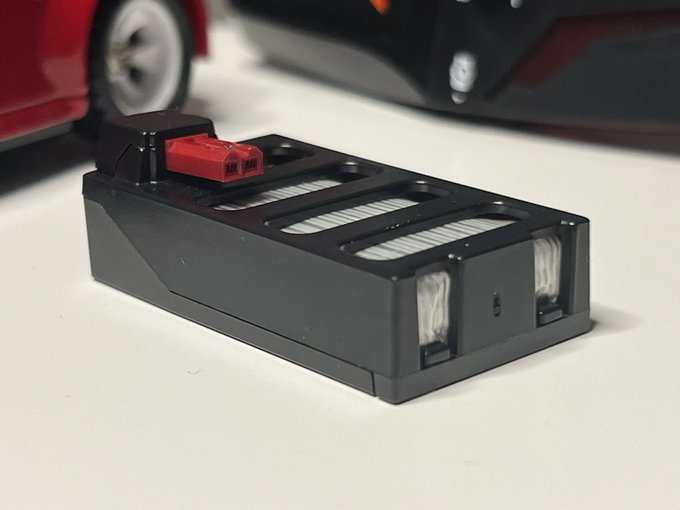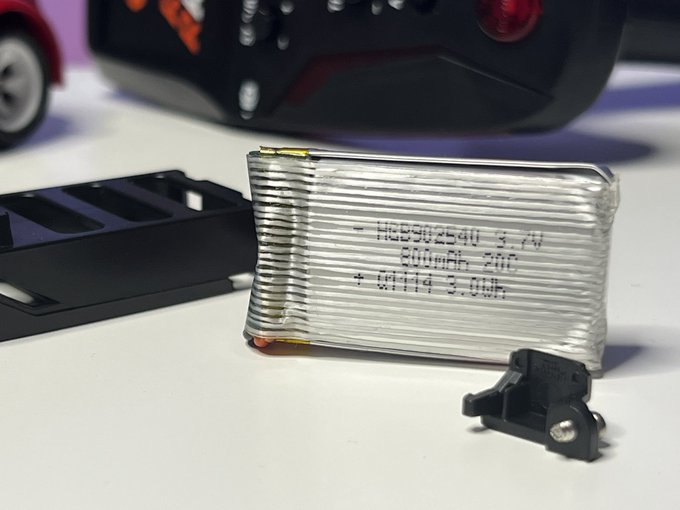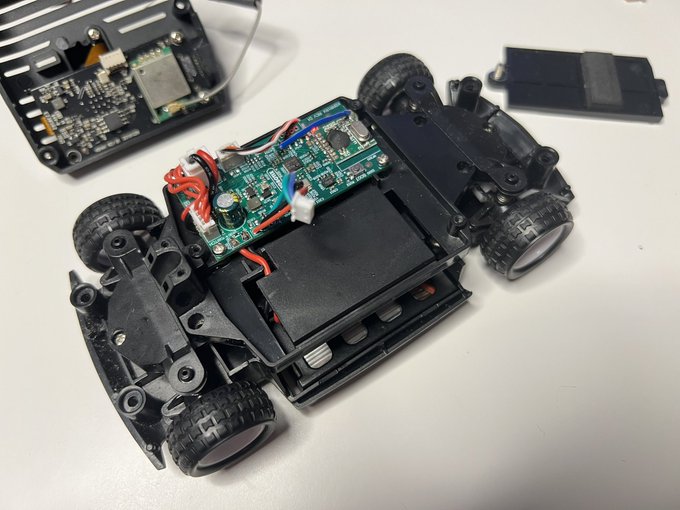Kobotix Real Racer FPV, RC Car Review
The Real Racer from Kobotix is a fast, precise and compact remote control car that handles beautifully and is a joy to zip around your living room. It doesn’t stop there, though; on top is a small camera which provides a live video feed – via WiFi no less – to your smartphone. But wait, there’s more; put your smartphone into the provided headset and you’ve got a hands-free, real-time, immersive, drivers-seat view of your RC menace as you tear around the house.
The green one was a bit rushed because I was dashing off to tend crying baby but here’s an example with better framing and focus. pic.twitter.com/t9HKtriZXK
— Phil Howard (@Gadgetoid) November 24, 2022
While FPV (first-person view) RC cars are nothing new, the Real Racer is competently put together and the WiFi approach to streaming video brings with it the possibility of video capture via an OBS Studio plugin (alas only for macOS and Windows).
Real Racer is ideal for beginners who don’t want to delve into the deep and endless world of hobbyist RC cars. Like me, basically. It offers video recording and snapshots onto an internal microSD card and the required smartphone app includes a brief onboarding process to get you started. My review unit came with an 8GB card included, but the retail specs say you’ll have to bring your own, or record directly to your phone.
Last year I picked up a couple of extremely cheap – £7.50 each – RC cars from Argos because we’d had a fresh laminate floor laid, no furniture in the house and I was keen to unleash RC havoc upon it. These cars were surprisingly detailed for the price, and they were quite fun to drive, but they were fairly clumsy and imprecise. You’ll find most cheap RC cars forgo any kind of speed or steering nuance in lieu of just having buttons that steer at full lock and give you three speeds: GO. STOP. GO BACKWARDS. Usually you’ll find these buttons are just buttons on a game-controller-esque remote, and sometimes they’ll be disguised as a trigger/steering wheel style remote that manages to be equally as terrible.
This tiny ass RC car was £7.50 and it still has a 5mm @LandRover_UK badge on it ?? pic.twitter.com/Rh0osyErms
— Phil Howard (@Gadgetoid) April 23, 2021
The Real Racer is quite a different proposition. It has such a wide steering and speed range that you’re given trim knobs in order to limit them and give you some chance of mastering control over this tiny car.
It’s actually quite a marvel – albeit I suspect RC car enthusiasts will laugh at me here – to turn the car upside-down and observe just how precisely and quickly the front wheels respond to you turning the steering wheel. It’s this accurate steering control which lets you reliably thread the Real Racer through small obstacles once you’ve had a little practice. And the sheer brute force speed of both the steering and the car will let you pull off some impressive J-turns. Albeit it’s slow to switch from forward to reverse – possible to stop the forces involved from stripping the car’s gearbox- something that has inevitably happened to the cheap RC cars I picked up (honestly they both sound terrible now!).
At its top, unlimited speed the Real Racer makes short work of even the largest rooms, though the precise steering control still lets you weave and dodge around furniture with a remarkable amount of elegance. The speed limit trim will dial all the way down to leaving the car stuck at a dead stop while the speed controller hums away futility. This is sort of… odd… but with a little trial and error it’s nonetheless easy to find a top speed at which you’re comfortable driving. Or – in my case – a speed at which you’re comfortable allowing your toddler to drive. Once you gain some confidence, however, the limit becomes largely redundant and you’ll find the trigger gives you a full range of speed control on the fly. With a flick of your finger you can go from crawling along like you’re traversing a busy supermarket carpark, to opening it up like you just ignited a fifty story solid state rocket in your boot.
It’s this range and precision of control that I really craved from an RC car and I’ve never – despite owning a remote control hovercraft in my childhood – quite tried one that feels this responsive. Perhaps the small size – roughly the same footprint as my smartphone – of the Real Racer has something to do with this.
Kobotix tout independent suspension and all-wheel drive, which is absolutely true but unfortunately not as useful for household traversal as it might sound. The front and rear axles have differentials which very noticeably help with steering and agility, but the suspension travel is pretty short. The bottoms of the shocks protrude out of the bottom of the car, affecting what little ground clearance this tiny car has. The net result of this is that the car drives best on hard floors, can handle most carpets relatively easily, but has trouble with the transition between the two. If you’ve limited the speed to slow, or don’t hit a floor to carpet transition quite fast enough, you’ll get marooned on the carpet edge and have to rescue your car. This, of course, is a nuisance if you’re blinkered by the FPV headset.
The wheels have independent suspension which is pretty cool, buuut… pic.twitter.com/VklImbhvXd
— Phil Howard (@Gadgetoid) November 24, 2022
If you struggle with steering there’s also a gyro assist feature which will help prevent you spinning out at corners. I’m not sure what magic is at play here, but since a gyroscope measures rotation it should be able to detect any discrepancies between the car steering angle and the actual trajectory of the car and make very fast micro corrections to the steering in order to compensate. I suspect there’s an accelerometer in there, too, which might be able to measure lateral G forces on the car. Kobotix don’t go into any detail, but whatever they’re doing- works. The car is, however, quite a lot more fun to drive with the steering assist turned off and it’s never quite obvious – from the remote alone, which has a single, unlabelled, mixed-use “aux” button – whether it’s turned on or off.
The Real Racer isn’t *just* an RC car. If the wide-angle camera lens and the mention of “FPV” mode didn’t give you a clue, it’s also capable of streaming wireless, low-latency video to your smartphone. It does this via a WiFi hotspot, by default, requiring the “Real Racer” app to be installed. (Yes that’s an extraordinarily generic name making it a little tricky to find on the app store.) Connecting via direct WiFi can be a little touch and go, since my iPhone likes a network with an internet connection (or a captive portal) and will give up and connect back to my home network on the first attempt to connect to the car. On the second attempt it’ll prompt me that it can’t find an internet connection (normal, since… it’s a car, not a router) but I’ve lost count of the number of times this pop-up has occurred once I’ve already put my phone into the FPV headset and put it on my head.
Once connected, the app gives you a better overview of the car’s status, including an icon which lights up when gyro assist is turned on, plus an on-screen icon to indicate that it’s recording. The app also provides buttons for recording video, capturing images and switching in/out of Headset mode (more on this in a moment.)
There are also a wealth of settings, including the ability to connect your car to your WiFi router, view and configure the microSD storage, configure streaming video quality, filter, AC power frequency flicker compensation, dynamic range and more. There’s a lot to delve into, but the defaults are sensible and – in practice – you never have to touch any of these settings. In fact things like the video filter- which applies a real-time effect to the video feed- are wholly superfluous, though I will admit the neon filter is pretty cool. Unfortunately the capture functionality runs entirely *on* the car and the video filters run entirely on your phone- so if you wanted to capture some cool video of you driving around a neon cyberpunk home obstacle course you would have to apply a filter manually afterwards.
You can also turn on and off the “idle notification” that the car will give you when you leave it sitting around for too long. I found out about this notification the hard way, when it scared the bejesus out of me. The car will wiggle its wheels quickly and quite loudly.
I suppose I should talk about the FPV headset now? It echoes most of my concerns with VR- it’s immersive and extremely fun, but you’ve got to curate your environment to ensure nothing untoward happens while your senses are being thoroughly occupied. This means keeping things like pets and toddlers in check since rescuing your car from a pickle means whipping the headset off first.
The headset is comfortable, though, and easily adjustable to get a reasonable view of my phone screen. The lack of stereo video- since the FPV car only has one camera you get the same image fed to each eye- is a little disappointing, but it doesn’t really affect how fun it is to zip around while looking effectively blindfolded to your bemused family.
The experience isn’t perfect, however, with the camera’s poor low-light performance being particularly noticeable. This is no surprise, since the lens is tiny compared to those in a modern smartphone. You’ll need a well-lit house to drive effectively and the oppressive darkness of a British winter will definitely put a damper on any attempt to drive outside during Christmas.
Put back together and working! Who dis? pic.twitter.com/kdAeHbu1EM
— Phil Howard (@Gadgetoid) November 24, 2022
Also, during my tests the RF control range gave out way before WiFi. I would often find myself delighting in zipping from the kitchen to the living-room or vice versa and suddenly finding that momentum had taken the car right out of the range of the controller. Normally this is fine, since you’d just walk closer, right? Not so when you’re blinded by an FPV headset. I suspect the lack of RF control range has something to do with the distinct lack of an antenna on the controller itself and – probably – more to do with a significant portion of my kitchen being *outside* the main walls of the house. If you want to zip around your downstairs, make sure your rooms aren’t separated by a double-skinned brick wall.
I should interject here (I am writing this after tearing down the Real Racer for a peek at the innards) that I found the RF antenna on the car – which was fully enclosed by the internal, plastic (ABS, probably) chassis – and lifted it up to peek through what I assume are air vents. It’s still enclosed by the outer body of the car, but I’d swear – albeit confirmation bias may be at play – that this gave me a better range.
The biggest downside with the Real Racer is the rigamarole required to charge the battery and Kobotix have some significant room for improvement here. The battery is a small LiPo inside a plastic enclosure with a protruding, red JST connector. It’s at least slightly more elegant than a naked battery, but still leaves a little to be desired.
The Real Racer battery comes in this plastic cradle, presumably to keep it protected and to prevent any flex on the wires- I know I always seem to manage to break my LIPOs ? pic.twitter.com/jmRSYAorgs
— Phil Howard (@Gadgetoid) November 24, 2022
The battery is installed into a screw compartment underneath the car, it needs to be connected via the car’s corresponding JST connector, tucked into the compartment and then the lid closed with a screw. There are- I think- a few good reasons for this but it makes removing, recharging and replacing the battery an absolute nuisance. It also means there’s a little wear and tear on the connectors every time you recharge the car. The connectors are particularly difficult to separate, too, exacerbating this little annoyance.
I’d have preferred either fully enclosed batteries with a quick-release system (and – while I’m indulging in wishful thinking – a charging cradle) or a USB Type-C or microUSB connector, and charging circuit in the car itself.
At the very least a spare battery would have been appreciated, or at the very, very least the ability to purchase one from the Kotobix store. Yes I know this kind of battery arrangement is stock standard for serious RC cars, but… Real Racer clearly isn’t serious, and clearly isn’t aimed at conventional hobbyists who want to faff about with this stuff.
Remove one screw and it comes apart revealing a pretty standard 800mAh LIPO. 1000mAh might fit ? pic.twitter.com/iTbn2zh33o
— Phil Howard (@Gadgetoid) November 24, 2022
Yes the fully removable battery means you can keep a couple handy for longer runs, but – at time of writing – you can’t buy another direct from Kobotox and – if you’re looking at *this car* for its entry, level, FPV fun – you probably don’t know exactly what battery you should be buying elsewhere. If you *want* to know- the supplied LiPo inside the plastic enclosure is a standard 3.7v, 800mAh. In fact the red mini JST (BEC) is part of the battery itself, and is just threaded through the enclosure into a holder on top. You can get 1000mAh batteries with roughly the same dimensions and the same, red JST connector (curse all my batteries for being JST-PH) if you want a small run time upgrade. Here’s an example from hyperflight.co.uk.
While spare batteries are no go (let’s face it, it’s probably due to shipping restrictions) you can buy replacement body shells and wheels for the car. Handy, since these are both likely to get dinged up over time. Kobotix also sell a “Custom Body Shell” that’s pre-coated in white primer and ready for you to paint. This means you’ve got four potential colours to race with friends. Sadly all of the alternate shells are the same, slightly cartoonish and ugly, style. While you won’t spend much time looking at the car – you’ll be too busy having fun – I’d still appreciate some variation here.
Tearing down the car revealed a pretty modular design that I suspect is quite repairable, and the RF part of the car will happily run without the WiFi/Camera/brain module connected. I’m left wondering what impact this might have on battery life, and whether a future revision could have the option to turn the FPV feature off entirely for a slightly longer runtime, traditional RC car.
It will power on and run quite happily with the camera/wifi board disconnected. Probably for a little longer, too!
The JST to the wifi board is just power and two wires for data- so probably UART. pic.twitter.com/yu6utn0v3s
— Phil Howard (@Gadgetoid) November 24, 2022
Yes the Real Racer is such fun to drive that I’ll probably be using it much more frequently without the rigamarole of the FPV headset than with. What’s the point of pulling off J-turns and drifting if you can’t see them? The microSD card can be replaced by removing the outer body, and is required (I think) for the WiFi/camera/brains module to boot successfully.
Overall it’s fair to say that the basic car functionality of Kobotix’s Real Racer exceeded my expectations and the FPV functionality is far more fun- albeit also inconvenient- than it has any business being. Sure you’ll have to whip the headset off and rescue your car from time to time, but with or without FPV mode the Real Racer delivers on its implicit promise: you’re gonna have a ton of fun.
As for the price, it’s currently on Amazon for a whopping £149.99 RRP – albeit on Black Friday sale for £119.99 – and it’s an awful, awful lot more expensive than those £7.50 RC cars that my toddler is still having fun with. The handling, speed and responsiveness of the car, however, is far, far beyond any cheap pretenders out there, and if you’ve got older kids (or yourself, ha!) then they’ll absolutely love it. Pets and people sensitive to noise, however, might not.
